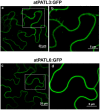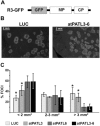Patellins 3 and 6, two members of the Plant Patellin family, interact with the movement protein of Alfalfa mosaic virus and interfere with viral movement
- PMID: 24751128
- PMCID: PMC6638666
- DOI: 10.1111/mpp.12146
Patellins 3 and 6, two members of the Plant Patellin family, interact with the movement protein of Alfalfa mosaic virus and interfere with viral movement
Abstract
Movement proteins (MPs) encoded by plant viruses interact with host proteins to facilitate or interfere with intra- and/or intercellular viral movement. Using yeast two-hybrid and bimolecular fluorescence complementation assays, we herein present in vivo evidence for the interaction between Alfalfa mosaic virus (AMV) MP and Arabidopsis Patellin 3 (atPATL3) and Patellin 6 (atPATL6), two proteins containing a Sec14 domain. Proteins with Sec14 domains are implicated in membrane trafficking, cytoskeleton dynamics, lipid metabolism and lipid-mediated regulatory functions. Interestingly, the overexpression of atPATL3 and/or atPATL6 interfered with the plasmodesmata targeting of AMV MP and correlated with reduced infection foci size. Consistently, the viral RNA levels increased in the single and double Arabidopsis knockout mutants for atPATL3 and atPATL6. Our results indicate that, in general, MP-PATL interactions interfere with the correct subcellular targeting of MP, thus rendering the intracellular transport of viral MP-containing complexes less efficient and diminishing cell-to-cell movement.
Keywords: AMV; ilarvirus; intercellular movement; movement protein; patellin.
© 2014 BSPP AND JOHN WILEY & SONS LTD.
Figures






Similar articles
-
The Plasmodesmal Localization Signal of TMV MP Is Recognized by Plant Synaptotagmin SYTA.mBio. 2018 Jul 10;9(4):e01314-18. doi: 10.1128/mBio.01314-18. mBio. 2018. PMID: 29991585 Free PMC article.
-
Control of Tobacco mosaic virus movement protein fate by CELL-DIVISION-CYCLE protein48.Plant Physiol. 2012 Dec;160(4):2093-108. doi: 10.1104/pp.112.207399. Epub 2012 Oct 1. Plant Physiol. 2012. PMID: 23027663 Free PMC article.
-
Synaptotagmin SYTA forms ER-plasma membrane junctions that are recruited to plasmodesmata for plant virus movement.Curr Biol. 2015 Aug 3;25(15):2018-25. doi: 10.1016/j.cub.2015.06.015. Epub 2015 Jul 9. Curr Biol. 2015. PMID: 26166780 Free PMC article.
-
Cellular Partners of Tobamoviral Movement Proteins.Int J Mol Sci. 2025 Jan 5;26(1):400. doi: 10.3390/ijms26010400. Int J Mol Sci. 2025. PMID: 39796254 Free PMC article. Review.
-
Missing links? - The connection between replication and movement of plant RNA viruses.Curr Opin Virol. 2012 Dec;2(6):705-11. doi: 10.1016/j.coviro.2012.09.007. Epub 2012 Oct 1. Curr Opin Virol. 2012. PMID: 23036608 Review.
Cited by
-
Identification of Phosphoinositide-Binding Protein PATELLIN2 as a Substrate of Arabidopsis MPK4 MAP Kinase during Septum Formation in Cytokinesis.Plant Cell Physiol. 2016 Aug;57(8):1744-55. doi: 10.1093/pcp/pcw098. Epub 2016 May 19. Plant Cell Physiol. 2016. PMID: 27335345 Free PMC article.
-
Phylogenetic analysis of plant multi-domain SEC14-like phosphatidylinositol transfer proteins and structure-function properties of PATELLIN2.Plant Mol Biol. 2020 Dec;104(6):665-678. doi: 10.1007/s11103-020-01067-y. Epub 2020 Sep 11. Plant Mol Biol. 2020. PMID: 32915352 Free PMC article.
-
Identifying Early Warning Signals for the Sudden Transition from Mild to Severe Tobacco Etch Disease by Dynamical Network Biomarkers.Viruses. 2019 Dec 20;12(1):16. doi: 10.3390/v12010016. Viruses. 2019. PMID: 31861938 Free PMC article.
-
Identification and Expression Analysis of Phosphatidylinositol Transfer Proteins Genes in Rice.Plants (Basel). 2023 May 26;12(11):2122. doi: 10.3390/plants12112122. Plants (Basel). 2023. PMID: 37299101 Free PMC article.
-
Role of SEC14-like phosphatidylinositol transfer proteins in membrane identity and dynamics.Front Plant Sci. 2023 May 15;14:1181031. doi: 10.3389/fpls.2023.1181031. eCollection 2023. Front Plant Sci. 2023. PMID: 37255567 Free PMC article. Review.
References
-
- Allen‐Baume, V. , Segui, B. and Cockcroft, S. (2002) Current thoughts on the phosphatidylinositol transfer protein family. FEBS Lett. 531, 74–80. - PubMed
-
- Aparicio, F. , Sánchez‐Navarro, J.A. and Pallas, V. (2006) In vitro and in vivo mapping of the Prunus necrotic ringspot virus coat protein C‐terminal dimerization domain by bimolecular fluorescence complementation. J. Gen. Virol. 87, 1745–1750. - PubMed
-
- Aparicio, F. , Sánchez‐Navarro, J.A. and Pallas, V. (2010) Implication of the C terminus of the Prunus necrotic ringspot virus movement protein in cell‐to‐cell transport and in its interaction with the coat protein. J. Gen. Virol. 91, 1865–1870. - PubMed
Publication types
MeSH terms
Substances
LinkOut - more resources
Full Text Sources
Other Literature Sources

